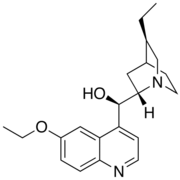Optochin

| |
| Names | |
|---|---|
| IUPAC name
(4β,8α,9R)-6'-Ethoxy-10,11-dihydrocinchonan-9-ol
| |
| Other names
Ethylhydrocupreine
| |
| Identifiers | |
3D model (JSmol)
|
|
| ChEBI | |
| ChEMBL | |
| ChemSpider | |
| ECHA InfoCard | 100.007.577 |
| MeSH | Optochin |
PubChem CID
|
|
CompTox Dashboard (EPA)
|
|
| |
| |
| Properties | |
| C21H28N2O2 | |
| Molar mass | 340.46 g/mol |
Except where otherwise noted, data are given for materials in their standard state (at 25 °C [77 °F], 100 kPa).
| |
Optochin (or ethylhydrocupreine hydrochloride) is a derivative of hydroquinine introduced in 1911 by Morgenroth and Levy with the intention to treat pneumococci infection.[1] In very high dilutions inhibits the growth of representatives of all four groups of pneumococci in vitro. That is the main reason it is now used in cell culture techniques for the presumptive identification of Streptococcus pneumoniae, which is optochin-sensitive, from other alpha-hemolytic streptococci such as viridans streptococci, which are resistant. A common mnemonic is "OVRPS" (Optochin - Viridans [are] Resistant, Pneumoniae [are] Sensitive). Or "VROPS" (Viridans Resistant [to] Optochin, Pneumoniae Sensitive)
The growth of bacteria that are optochin-sensitive will show a zone of inhibition around an optochin disc, while the growth of bacteria that are optochin-resistant will not be affected. In vitro, an minimum inhibitory concentration (MIC) of 1:10,000,000 will affect growth of pneumococcus, and 1:500,000 is bactericidal.[2]
Resistance
Strains of Streptococcus pneumoniae have been found to be resistant to optochin in laboratory testing.[3]
See also
References
- ^ Moore HF (1915). "THE ACTION OF ETHYLHYDROCUPREIN (OPTOCHIN) ON TYPE STRAINS OF PNEUMOCOCCI IN VITRO AND IN VIVO, AND ON SOME OTHER MICROORGANISMS IN VITRO". J. Exp. Med. 22: 269–85. doi:10.1084/jem.22.3.269. PMC 2125335. PMID 19867915.
- ^ http://chestofbooks.com/health/materia-medica-drugs/Pharmacology-Therapeutics-Prescription-Writing/Ethylhydrocupreine.html
- ^ Pikis A, Campos JM, Rodriguez WJ, Keith JM (2001), "Optochin resistance in Streptococcus pneumoniae: mechanism, significance, and clinical implications", Journal of Infectious Diseases, 184 (5): 582–590, doi:10.1086/322803, JSTOR 30137322, PMID 11474432
